Incarvillea: cultivation features and care tips
Incarvillea has another, more familiar name - garden gloxinia. This plant is familiar to many gardeners because of its magnificent bright buds, which become an excellent element of landscape decor. Incarvillea was named in memory of the famous botanist Pierre D'Incarville, who in China collected a unique collection of plants, the pearl of which was this magnificent flower. It is not difficult to grow garden gloxinia, this species takes root well in the middle lane.
Content:
- Types of incarvillea and their appearance
- Care requirements for Incarvillea
- Reproduction of garden gloxinia
- Using incarvillea on site
Types of incarvillea and their appearance
In Europe, this is not a very common plant, but now it is starting to occur more often, as it deserves the closest interest of gardeners. Only 14 species of this flower are known, they differ quite strongly among themselves. Among them are annuals and perennial varieties, the plants can be herbaceous or subshrub. Stems in all species are erect, they can be either simple or branched.
All species are characterized by thickened rhizomes, like dahlias.
Garden gloxinia is grown because of the beautiful greenery and magnificent bright buds that can delight the eye for a long time. The flowers are red, pink, white, yellow, outwardly they resemble the buds of indoor gloxinia, which explains the second name of the plant.
Today, the most common are four types of Incarvillea, which are grown in many countries:
- Incarvillea grandiflora is a large-flowered species. The height of this plant is no more than 30 cm, it has bright pink buds with a yellow center. It is a winter-hardy variety that can survive the Russian cold without additional shelter.
- Incarvillea delavayi - Incarvillea Delaway is a more common variety, its height is up to 60 cm. It differs in feathery leaves, flowers can have a dark pink ooze, light pink hue. This species does not differ in winter hardiness, therefore, when growing it, you need to know protection technologies.
- Incarvillea compacta - dense incarvillea has purple flowers located on short stems, the height of which does not exceed 30 cm. It has leaves with whole lobes, they are located near the root.
- Incarvillea mairei - Incarvillea mairei is a small winter-hardy plant that will delight the owner with large pink buds. The leaves have a slightly dissected shape, this look looks very compact and elegant. It is easy to grow it: this species will survive the winter quite calmly, and in the presence of mulch, it calmly withstands even harsh cold weather.
All of these types of Incarvillea are characterized by long flowering: new buds can appear for 6-7 weeks in a row, that is, almost all summer. In some cases, they can bloom a second time at the very beginning of autumn, if the plant is provided with everything necessary for good growth.
Care requirements for Incarvillea
Garden gloxinia is not a very demanding flower, but if you create the right conditions for it, you can achieve more lush and abundant flowering.It is important for her to choose the right place in the garden: most of all, this flower is suitable for a rock garden and placement on the slopes, since its roots are very afraid of getting wet.
Even if you plant it in flower beds and flower beds, they need to be raised above ground level.
In order to get large flowers as early as possible, it is recommended to provide the Incarvillea with the following growth conditions:
- Lighting. To get large flowers, you need to choose a well-lit place, you can also grow it in light partial shade. Direct sunlight is not beneficial to the plant, so it is important to find the right balance.
- The soil. For a plant, the best solution is nutritious sandy loam soil, in which it is imperative to organize a drainage layer. It is made from coarse sand or fine gravel, for this you can grow Incarvillea in rocky areas.
- Watering is necessary in moderation to prevent root rot. At the same time, the soil should not dry out.
- Top dressing is required when transplanting plants: complex mineral fertilizers or organic matter must be applied to the soil. For these purposes, infusion of mullein is often used, which is additionally introduced into the soil during the active growth of a young plant. However, it is important not to overdo it: over-feeding can reduce the winter hardiness of Incarvillea.
- Preparation for wintering. Although garden gloxinia is considered a hardy plant, it needs to form a protective layer. Mulching is carried out before frost, the rhizome is covered with about 10 cm of mulch: it includes peat, sawdust, shavings, fallen needles, etc. When it gets warmer, the protective layer must be removed to prevent decay of the rhizomes. Young plants for the winter are closed on top with ordinary plastic cans, which provide additional protection to Satan from the autumn rains.
The rhizomes of plants, when the ground part dies, are dug up and sent to storage in the cellar, like a dahlia.
It is not difficult to organize good conditions for this plant, since it does not impose any special requirements. It is enough to follow the general recommendations for the incarvillea to take root and start delighting the owner with large interesting flowers.
Reproduction of garden gloxinia
This plant can be propagated in several ways: by seeds, cuttings, sometimes I use the division of rhizomes.
Experienced gardeners prefer working with seeds, as using this method you can achieve interesting new color combinations in the buds, and it will allow you to carry out your own breeding work. Some argue that only seed propagation allows you to get the most resistant and viable plants.
Incarvillea is growing rapidly, so the transplant effort will pay off very soon.
The seeds are placed in the ground to a depth of 1 cm and watered well. After a week, you can wait for the first shoots to appear: seedlings usually appear unevenly. In the future, the sprouts that have gained strength can be easily transplanted into open ground in a flower bed. The pick is carried out when the plant already has real leaves. Seedlings do not take root very well, so many gardeners immediately place Incarvillea seeds in open ground - in this case, the germination rate may be even higher.
Much more commonly used propagation by cuttingsas this is the easiest method for beginner gardeners:
- For him, one large and healthy leaf is cut from the rosette of leaves, which should also have a part of the stem.
- The end of the cutting must be immersed in a special solution that promotes rapid root growth, such preparations are sold in special pharmacies and stores.
- After planting, the stalk gives roots for at least 2-3 weeks, and a fully formed rosette of leaves with peduncles will appear only from next year.
- After a year, the plant forms tuberous roots, which can later be used for reproduction.
At the very beginning of spring or early autumn, you can use this type of breeding, like dividing a bush:
- With a shovel or knife, the rhizome is divided into parts so that on all processes there are growth points for new shoots.
- After that, the resulting seed is buried in the soil, the root collar should be located about 5 cm below the surface.
- Planting in the ground should be carried out only after the temperature reaches 18-20 degrees, otherwise the rhizome may not take root.
Using incarvillea on site
Incarvillea is an amazingly beautiful plant that can easily be turned into the queen of any garden... Garden gloxinia opens up rich opportunities for flower decorations, especially if several species are grown on the site at once. It is placed in rock gardens, as it looks great among stones, it can also be placed on various hills.
The homeland of this flower is China, so it can be the best solution if the house is decorated in an oriental style.
This plant will decorate the site with large flowers with a pleasant aroma, and varieties can be selected according to the color of the buds. It is easy for him to find a place near the house, it can be located in a flower garden, integrating into the overall composition. In addition, it can be placed separately, then the incarvillea will become a good decorative decoration for the site and will always be in sight.




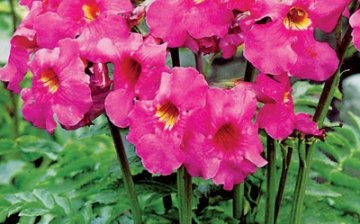
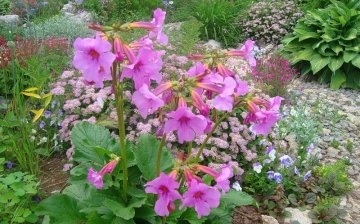
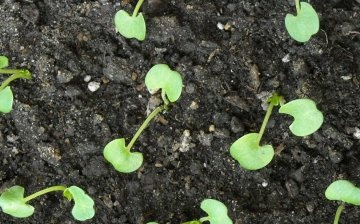
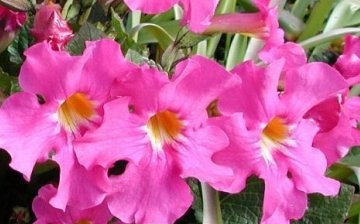





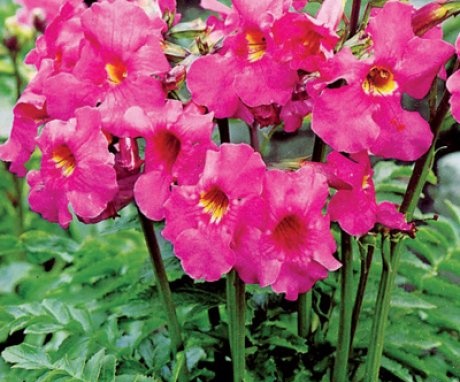
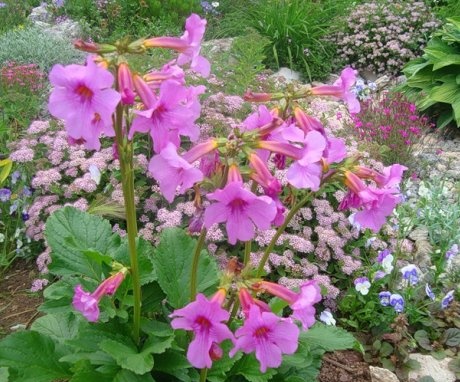
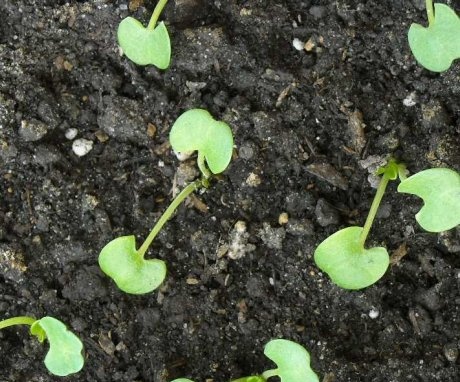
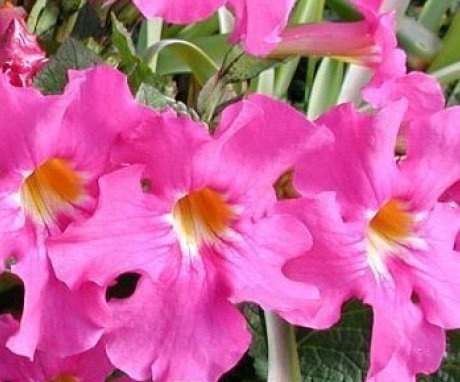
I grow Incarvillea for the first year. First I bought the seeds, and then I saw the tuber in the store - I bought it. From the tuber, complex leaves were quickly dissected, and soon a peduncle appeared. The flowers opened when the peduncle was about 15 cm, and over time it increased to 50 cm. Now the seeds are already ripening in the pods. I like this plant very much. Out of 9 seeds - only 2 pieces, I hope to see them bloom next year. I probably will not dig up young plants for the winter, I will only warm them.